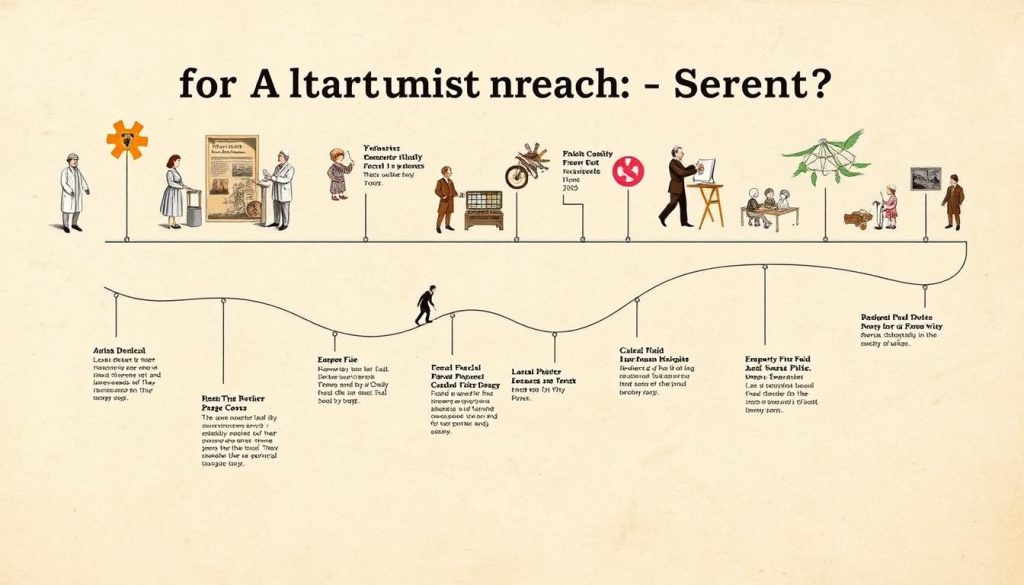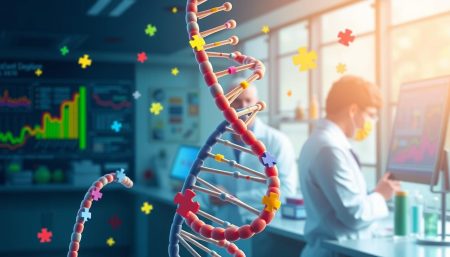The history of autism is a captivating story. It spans from early medical notes to major breakthroughs. These discoveries have greatly improved our grasp of autism.
The discovery of autism was not sudden. It took many years to develop. This journey has been filled with important moments and figures.
Exploring autism’s origins, we find key players and events. These have led to today’s autism research. Our journey covers from the early 1900s to now. It shows how our understanding of autism has grown.
The Origins of Autism Research in Medical History
Autism research has a long history that many don’t know about. Doctors noticed unique behaviors long before autism was named. These early findings helped shape how we diagnose autism today.
Early Medical Observations
In the 18th and 19th centuries, doctors saw behaviors we now link to autism. They described kids who seemed to be in their own world, had trouble talking, and repeated actions. These early observations were the start of understanding autism.
Initial Documentation
In the late 1800s, the first medical writings about autism-like behaviors emerged. Doctors talked about kids who didn’t speak or act like others. These early reports were key steps in the history of autism research.
Pre-20th Century Cases
Before 1900, there were several notable cases that hinted at autism. One famous case is Hugh Blair of Borgue, a Scottish nobleman from the 1700s. His behavior, documented in legal papers, fits what we know as autism today. These cases show autism has been around for a long time, influencing our understanding of it.
When Was Autism Discovered: The Groundbreaking Work of Leo Kanner
Dr. Leo Kanner is credited with discovering autism in 1943. His paper, “Autistic Disturbances of Affective Contact,” was a major breakthrough. It is a key moment in autism research.

Kanner studied 11 children at Johns Hopkins Hospital. He found they had trouble with social skills, talking, and repeating actions. His findings helped us understand autism as a unique condition.
Kanner’s work had a big impact. It started a new area of study in developmental psychology. His work also helped shape how we diagnose and treat autism today.
- Kanner identified common traits among autistic children
- His research differentiated autism from childhood schizophrenia
- The term “infantile autism” was introduced in his paper
Kanner’s 1943 research marked autism as a distinct condition. His work is seen as the first detailed look at autism. It’s a key moment in understanding developmental disorders.
Hans Asperger’s Parallel Research and Contributions
While Leo Kanner was advancing autism research in the United States, Hans Asperger was working in Vienna. Their efforts in the 1940s were key to understanding autism.
Differences in Observations
Asperger studied children with better language skills and intelligence. He noticed their social struggles and focused interests. He called this “autistic psychopathy,” helping us see autism as a spectrum.
Impact on Modern Understanding
Asperger’s work changed how we see autism today. He identified high-functioning autism, now part of autism spectrum disorder. This broader view helps us support more people.
Research in Vienna
Asperger researched at Vienna’s University Children’s Hospital during World War II. His work, despite the odds, was a big step in autism research. It shows the importance of early research milestones.
| Aspect | Kanner’s Research | Asperger’s Research |
|---|---|---|
| Focus Group | Children with language delays | Children with advanced language skills |
| Key Observations | Social withdrawal, repetitive behaviors | Social difficulties, narrow interests |
| Term Used | “Early infantile autism” | “Autistic psychopathy” |
Evolution of Diagnostic Criteria Through the Decades
Autism diagnosis has changed a lot over the years, starting in the 1940s. Important research milestones have helped us understand autism better.
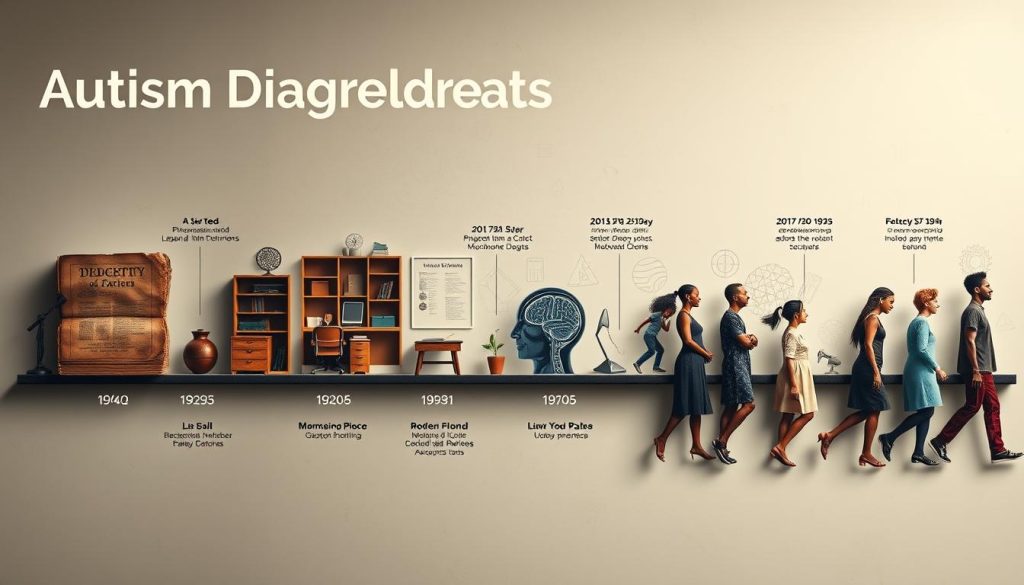
In 1952, the DSM-I didn’t list autism as a diagnosis. It wasn’t until 1980 that the DSM-III included “Infantile Autism” as a unique category.
The 1987 DSM-III-R update changed the name to “Autistic Disorder.” This change showed that autism can present in many ways.
| Year | Diagnostic Manual | Key Change |
|---|---|---|
| 1952 | DSM-I | No specific autism diagnosis |
| 1980 | DSM-III | Introduction of “Infantile Autism” |
| 1987 | DSM-III-R | Expanded criteria, “Autistic Disorder” |
| 1994 | DSM-IV | Added Asperger’s Syndrome |
| 2013 | DSM-5 | Introduced Autism Spectrum Disorder |
The DSM-5, released in 2013, was a big change. It brought together different autism diagnoses under “Autism Spectrum Disorder.” This change recognized that autism traits can vary and that different levels of support are needed.
The Role of Parent Advocacy in Autism Recognition
Parent advocacy has been key in understanding autism. Families faced many challenges in getting help for their children. So, they started grassroots organizations to make a difference.
Formation of Early Support Groups
In the 1960s and 1970s, parents of autistic kids started support groups. These groups let families share their stories and support each other. They also pushed for better services. The National Autistic Society in the UK and the Autism Society of America were among the first, marking a big step forward.
Impact on Research Funding
Parent groups have played a big role in getting money for autism research. They raised awareness and lobbied for funds. This effort has led to more research, better diagnostic tools, and new ways to help.
Changing Public Perception
Parent advocates have worked hard to change how people see autism. They’ve fought stereotypes and pushed for acceptance. Their efforts have helped make society more inclusive for autistic individuals.
| Year | Milestone | Impact |
|---|---|---|
| 1965 | Formation of National Autistic Society (UK) | First organized parent advocacy group for autism |
| 1970 | Autism Society of America established | Nationwide support network in the US |
| 1990 | Autism included in Individuals with Disabilities Education Act | Improved educational support for autistic students |
| 2000 | Children’s Health Act passed | Increased federal funding for autism research |
Developmental Theories and Research Milestones
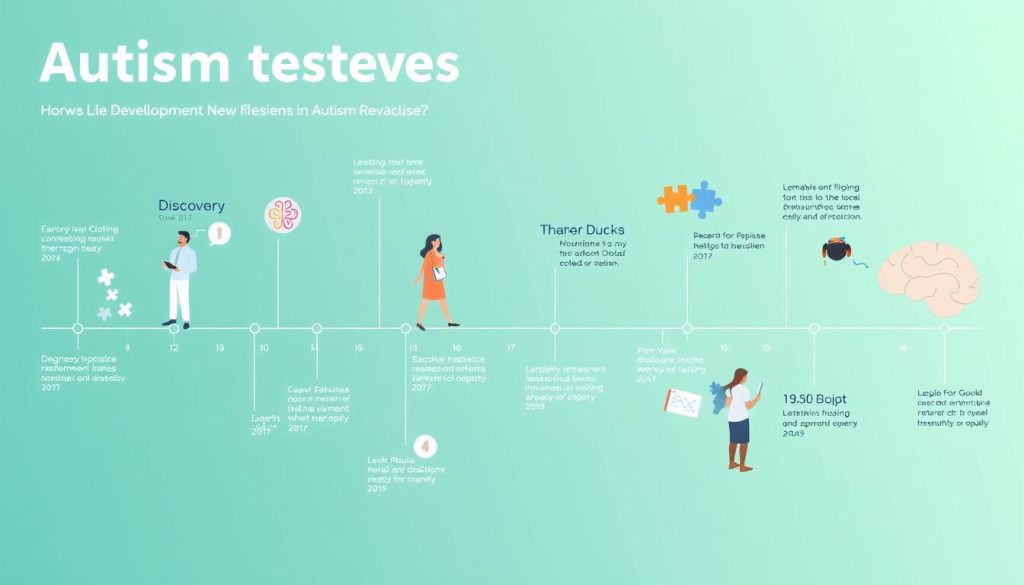
The field of autism research has made big strides over the years. Key dates in autism research highlight important moments that have changed how we see this complex condition. From the first observations to major studies, these milestones have helped us better diagnose and treat autism.
In the 1960s, researchers started looking into the cognitive side of autism. They found unique ways people with autism process information and interact with their world. This led to the creation of several key theories.
- Theory of Mind: Introduced in the 1980s, it says people with autism might find it hard to get others’ thoughts and feelings.
- Executive Function Theory: This theory talks about problems with planning, organizing, and adjusting to new things.
- Central Coherence Theory: It explains why people with autism might focus on details more than the overall picture.
These theories have greatly shaped autism research and therapy. They’ve helped us see autism as a spectrum disorder. This means we now understand that people with autism have a wide range of experiences and abilities.
Recently, there’s been a lot of work in genetic studies, brain imaging, and early intervention. These new findings are making our understanding of autism even better. They bring hope for better support and understanding for those on the autism spectrum.
Genetic Research Breakthroughs in Autism Studies
Genetic research has been key in understanding autism. It has marked important milestones in autism research. Twin studies have shown that autism has a strong genetic link.
Twin Studies and Hereditary Factors
Twin studies have shown that autism has a strong genetic link. Research has found that if one identical twin has autism, the other twin is more likely to have it too. This discovery has been a major breakthrough in autism research.
Gene Identification Progress
Researchers have made big strides in finding specific genes linked to autism. Recent advances in autism genetics research have shown that both rare and common gene variants play a role in autism risk. These findings have broadened our understanding of autism.
Modern Genetic Testing Methods
Today, genetic testing for autism is more advanced. Methods like whole-genome sequencing allow scientists to look at a person’s entire genetic makeup. This technology has helped discover new autism-related genes and how they interact.
| Genetic Testing Method | Description | Benefits |
|---|---|---|
| Whole-Genome Sequencing | Examines entire genetic makeup | Identifies new autism-related genes |
| Microarray Analysis | Detects large chromosomal changes | Reveals copy number variations |
| Targeted Gene Panels | Tests specific autism-associated genes | Provides focused, cost-effective screening |
These genetic research breakthroughs have greatly improved our understanding of autism. They have opened the door to more personalized diagnosis and treatment.
The Emergence of Autism Spectrum Disorder Classification
The way we diagnose autism has changed a lot over time. Before, people thought autism was just one thing with certain signs. This old view made it hard to understand and often left people without a diagnosis or wrong one.
As scientists learned more, they saw that autism looks different in everyone. This big change in thinking led to a new way of seeing autism. Now, we understand it as a spectrum, with a wide range of symptoms and abilities.
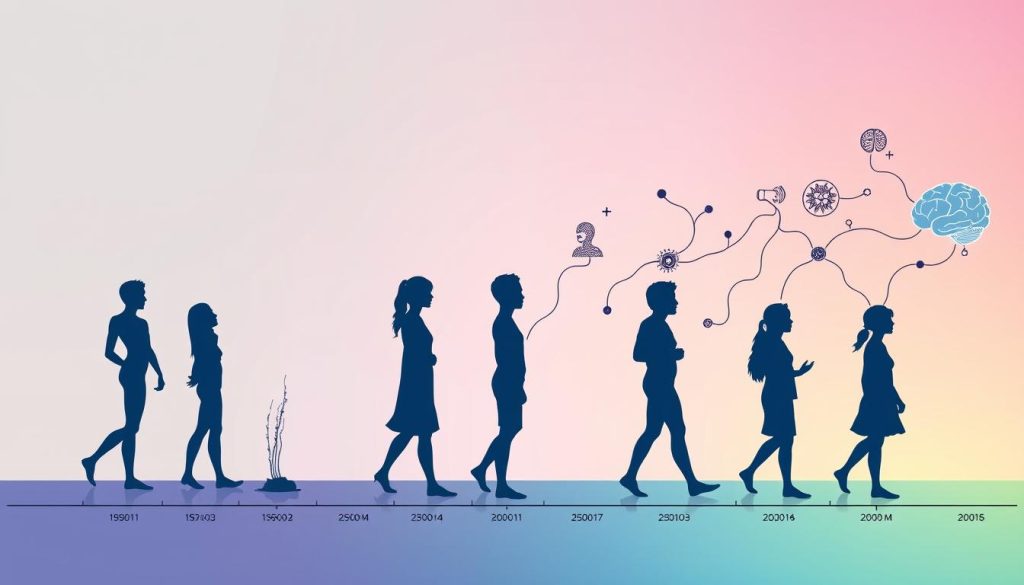
The spectrum idea changed how we see autism. It shows that autism can be mild or very severe. Some people might talk well but find it hard to connect with others. Others might be great at certain things but struggle with everyday tasks.
This new way of classifying autism has helped more people get diagnosed early. It also means they get support that fits them better. The spectrum model also shows the special talents many people with autism have. This has helped reduce shame and increase acceptance of being different.
Our understanding of autism is always growing. New research keeps helping us improve how we support and teach people with autism. This shows how important it is to have flexible, person-focused ways of helping and learning about autism.
Impact of Brain Imaging Technologies on Autism Research
Brain imaging technologies have changed how we study autism. They have shown us new things about this complex condition. These tools let scientists look into the brain’s inner workings, giving us key insights.
MRI Studies and Findings
Magnetic Resonance Imaging (MRI) has been a big help in autism research. MRI studies have found different brain structures and functions in people with autism. This has led to finding early signs and ways to help sooner.
Neurological Markers Discovery
Discovering neurological markers has been a major step forward. Scientists have found certain brain areas and paths linked to autism. This discovery has opened doors for new treatments and help.
| Brain Region | Associated Autism Traits | Potential Interventions |
|---|---|---|
| Amygdala | Social behavior, emotion processing | Social skills training, emotion regulation techniques |
| Prefrontal Cortex | Executive function, attention | Cognitive behavioral therapy, organizational skills training |
| Cerebellum | Motor coordination, language | Physical therapy, speech and language therapy |
As brain imaging gets better, researchers are excited for more discoveries. These tools are key to improving our understanding and treatment of autism.
Significant Changes in Treatment Approaches Over Time
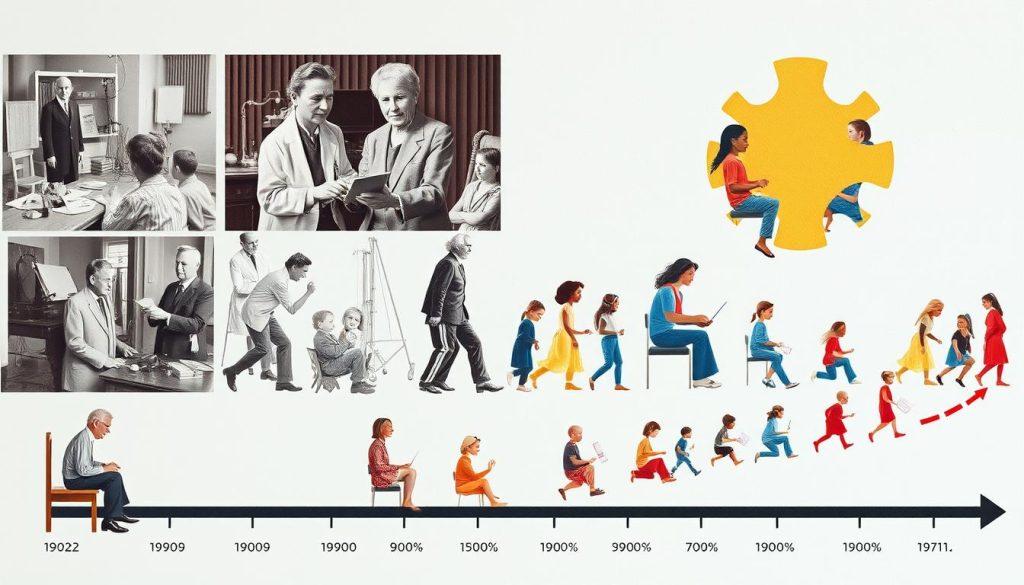
The history of autism treatment has seen big changes. In the past, treatments were often harsh. Now, we use gentler methods.
In the 1960s, applied behavior analysis became a key method. It used rewards to teach good behaviors. The 1980s brought a focus on developmental approaches. These methods aimed to improve social skills through play.
As we learned more, treatments became more tailored. Doctors realized autism is a spectrum disorder. This meant treatments had to be more individualized.
Today, we use evidence-based practices in treating autism. These include:
- Speech and language therapy
- Occupational therapy
- Social skills training
- Cognitive behavioral therapy
Medications help manage symptoms like anxiety or hyperactivity. But they don’t cure autism. The goal is early intervention and lifelong support.
Now, families play a big role in treatment. Parents and siblings get training to help at home. This approach aims to enhance life for those with autism in all settings.
The Rise of Early Intervention Programs
Early intervention programs are key in understanding autism. They help find and treat autism in young kids. This is a big step in how we treat autism today.
Development of Screening Tools
Screening tools are vital for early detection. Doctors use special questionnaires and observations to find autism in toddlers. This makes diagnosing autism faster and more accurate, leading to earlier help.
Evidence-Based Interventions
Our knowledge of autism has grown, so have the treatments. ABA, speech therapy, and occupational therapy are common and proven to work. They help with communication, social skills, and daily tasks.
| Intervention Type | Target Skills | Typical Frequency |
|---|---|---|
| Applied Behavior Analysis | Behavior, communication, social skills | 20-40 hours/week |
| Speech Therapy | Language, communication | 1-2 sessions/week |
| Occupational Therapy | Fine motor skills, sensory processing | 1-2 sessions/week |
Impact on Outcomes
Early intervention programs have made a big difference. Kids who get help early often do better in language, social skills, and thinking. This shows how important early detection and treatment are.
The growth of early intervention programs is a big win for autism care. By focusing on early detection and proven treatments, these programs help us understand autism better. They also improve life for those with autism.
Cultural Perspectives on Autism Throughout History
Autism’s history is rich and varied across cultures. In some places, people with autism were seen as gifted or blessed. Others thought they were cursed or possessed. These beliefs greatly influenced how communities treated them.
As we learned more about autism’s origins, awareness grew worldwide. Western medicine’s research and treatments spread globally. But, many cultures kept their traditional views, blending old and new.
Now, autism is recognized everywhere, but cultural differences remain. Some countries start early interventions, while others face stigma. These views continue to shape research, aiming for more inclusive studies for all.
FAQ
Q: When was autism first officially recognized as a distinct condition?
A: Autism was first recognized in 1943 by Dr. Leo Kanner. He published a paper called “Autistic Disturbances of Affective Contact.” This paper is seen as the start of autism’s recognition today.
Q: Who were the key pioneers in autism research?
A: Dr. Leo Kanner and Dr. Hans Asperger were key in autism research. Kanner described what we now call classic autism in 1943. Asperger described a similar condition, now known as Asperger’s syndrome, in 1944. Their work is the base of today’s autism research.
Q: How has the understanding of autism evolved over time?
A: Our understanding of autism has grown a lot. At first, it was seen as rare. Now, it’s known as a spectrum disorder with different levels of severity. We know more about its genetic and neurological roots today.
Q: What role did parent advocacy play in autism recognition?
A: Parents were key in recognizing autism. They formed support groups and raised awareness. They also pushed for more research funding and challenged old theories. Their efforts changed how people saw autism and helped advance research and treatments.
Q: How has genetic research contributed to our understanding of autism?
A: Genetic research has helped us understand autism. Twin studies showed it’s hereditary. Modern research has found many genes linked to autism risk. This has helped us understand autism’s biological side and how to intervene.
Q: What impact have brain imaging technologies had on autism research?
A: Brain imaging, like MRI, has been a big help in autism research. It lets researchers study autism brains. This has shown us how autism brains are different, giving us insights into autism’s causes.
Q: How have treatment approaches for autism changed over time?
A: Autism treatments have changed a lot. Early treatments focused on behavior. Now, we use more individualized, early interventions. We focus on improving life quality and supporting strengths, not trying to “cure” autism.
Q: What is the significance of early intervention in autism?
A: Early intervention is very important in autism treatment. Studies show early, intense interventions can greatly help children with autism. This has led to better screening tools and early programs.
Q: How do cultural perspectives influence autism understanding and treatment?
A: Cultural views greatly affect how we understand and treat autism. Different cultures see autism differently, which changes diagnosis and treatment. It’s important to be aware of these differences to provide the best care worldwide.












